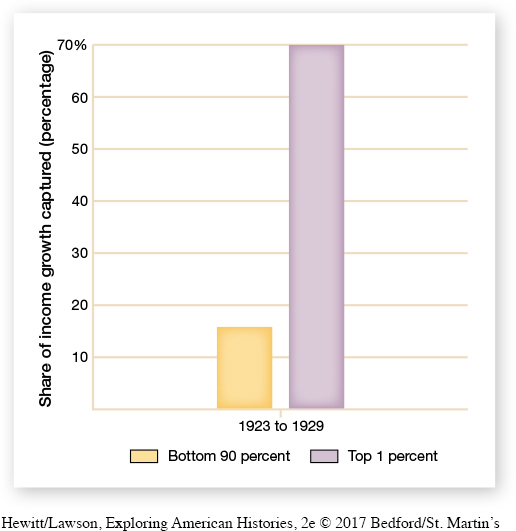Perilous Prosperity
Prosperity in the 1920s was real enough, but behind the impressive financial indicators flashed warnings that profound danger loomed ahead. Perhaps most important, the boom was accompanied by growing income inequality. A majority of workers lived below the poverty line, and farmers plunged deeper into hard times. Corporate profits increased much faster than wages, resulting in a disproportionate share of the wealth going to the rich. The combined income of the top 1 percent of families was greater than that of the 42 percent at the bottom (Figure 21.2); 66 percent lived below the income level necessary to maintain an adequate standard of living.

Income inequality was a critical problem because America’s new mass-production economy depended on ever-increasing consumption, and higher income groups could consume only so much, no matter how much of the nation’s wealth they controlled. While the expansion of consumer credit helped hide this fundamental weakness, the low wages earned by most Americans drove down demand over time. Cutbacks in demand forced manufacturers to reduce production, thereby reducing jobs and increasing unemployment, which in turn dragged down the demand for consumer goods even further. As a result, by 1926 the growth of automobile sales had begun to slow, as did new housing construction—signs of an economy heading for trouble.
At the same time, the wealthy few used their disproportionate wealth to speculate in the stock market and risky real estate ventures. To encourage investments, brokers promoted buying stocks on margin (credit) and required down payments of only a fraction of the market price. Without vigilant governmental oversight, banks and lending agencies extended credit without taking into account what would happen if a financial panic occurred and they were suddenly required to call in all of their loans. To make matters worse, the banking system operated on shaky financial grounds, combining savings facilities with speculative lending operations. With minimal interference from the Federal Trade Commission, businesspeople frequently managed firms in a reckless way that created a high level of interdependence among them. This interlocking system of corporate ownership and control meant that the collapse of one company could bring down many others, while also imperiling the banking houses that had generously financed them.
Rampant real estate speculation in Florida foreshadowed these dangers. In many cases, investors bought properties sight unseen, as speculators and unscrupulous agents worked under the assumption that land values in Florida would continue to increase forever. However, severe storms in 1926 and 1928 abruptly halted the rise in land values. Land prices spiraled downward, speculators defaulted on bank loans, and financial institutions tottered.
Throughout the 1920s, fortunes plummeted for farmers as well. Declining world demand following the end of World War I, together with increased productivity because of the mechanization of agriculture, drove down farm prices and income. Between 1925 and 1929, falling wheat and cotton prices cut farm income in half. The collapse of farm prices had the most devastating effects on tenants and sharecroppers, who were forced off their lands through mortgage foreclosures. Around three million displaced farmers migrated to cities.
Internationally, the United States encountered serious economic obstacles. World War I had destroyed European economies, leaving them ill equipped to repay the $11 billion they had borrowed from the United States. Much of the Allied recovery, and hence the ability to repay debts, depended on obtaining the reparations imposed on Germany at the conclusion of World War I. Germany, however, was in even worse shape than France and Britain and could not meet its obligations. Consequently, the U.S. government negotiated a deal by which the United States provided loans to Germany to pay its reparations and Britain and France reduced the size of Germany’s payments. The result was a series of circular payments. American banks loaned money to Germany, which used the money to pay reparations to Britain and France, which in turn used Germany’s reparations payments to repay debts owed to U.S. banks. What appeared a satisfactory resolution at the time ultimately proved a calamity. In undertaking this revolving-door solution, U.S. bankers added to the cycle of spiraling credit and placed themselves at the mercy of unstable European economies. Compounding the problem, Republican administrations in the 1920s supported high tariffs on imports, reducing foreign manufacturers’ revenues and therefore their nations’ tax receipts, making it more difficult for these countries to pay off their debts.
REVIEW & RELATE
Describe the relationship between business and government in the 1920s.
Why was a high level of consumer spending so critical to 1920s prosperity, and why was the economic expansion of the 1920s ultimately unsustainable?
Exploring American HistoriesPrinted Page 695
Exploring American Histories Value EditionPrinted Page 513
Chapter Timeline